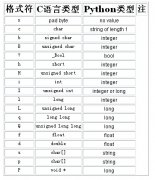python中实现定制类的特殊方法总结(3)
总之,通过上面的方法,我们自己定义的类表现得和Python自带的list、tuple、dict没什么区别,这完全归功于动态语言的“鸭子类型”,不需要强制继承某个接口。
__getattr__
正常情况下,当我们调用类的方法或属性时,如果不存在,就会报错。比如定义Student类:
class Student(object):
def __init__(self):
self.name = 'Michael'
调用name属性,没问题,但是,调用不存在的score属性,就有问题了:
>>> s = Student()
>>> print s.name
Michael
>>> print s.score
Traceback (most recent call last):
...
AttributeError: 'Student' object has no attribute 'score'
错误信息很清楚地告诉我们,没有找到score这个attribute。
要避免这个错误,除了可以加上一个score属性外,Python还有另一个机制,那就是写一个__getattr__()方法,动态返回一个属性。修改如下:
class Student(object):
def __init__(self):
self.name = 'Michael'
def __getattr__(self, attr):
if attr=='score':
return 99
当调用不存在的属性时,比如score,Python解释器会试图调用__getattr__(self, 'score')来尝试获得属性,这样,我们就有机会返回score的值:
>>> s = Student()
>>> s.name
'Michael'
>>> s.score
99
返回函数也是完全可以的:
class Student(object):
def __getattr__(self, attr):
if attr=='age':
return lambda: 25
只是调用方式要变为:
>>> s.age()
25
注意,只有在没有找到属性的情况下,才调用__getattr__,已有的属性,比如name,不会在__getattr__中查找。
此外,注意到任意调用如s.abc都会返回None,这是因为我们定义的__getattr__默认返回就是None。要让class只响应特定的几个属性,我们就要按照约定,抛出AttributeError的错误:
class Student(object):
def __getattr__(self, attr):
if attr=='age':
return lambda: 25
raise AttributeError('\'Student\' object has no attribute \'%s\'' % attr)
这实际上可以把一个类的所有属性和方法调用全部动态化处理了,不需要任何特殊手段。
这种完全动态调用的特性有什么实际作用呢?作用就是,可以针对完全动态的情况作调用。
举个例子:
现在很多网站都搞REST API,比如新浪微博、豆瓣啥的,调用API的URL类似:
http://api.server/user/friends
http://api.server/user/timeline/list
如果要写SDK,给每个URL对应的API都写一个方法,那得累死,而且,API一旦改动,SDK也要改。
- 上一篇:python错误处理详解
- 下一篇:python之wxPython菜单使用详解






